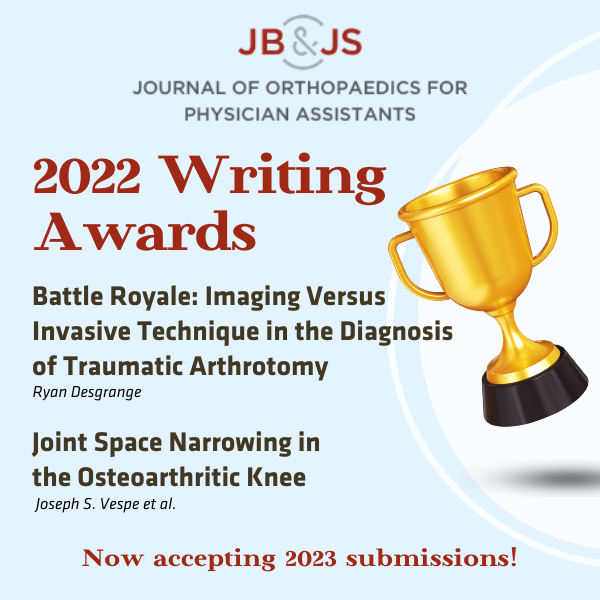JBJS Journal of Orthopaedics for Physician Assistants (JOPA) continues the tradition of recognizing outstanding papers. Awards are given for the best articles submitted during the previous calendar year by certified practicing physician assistants (PAs) or nurse practitioners (NPs).
In a recent editorial announcing the 2022 JOPA Writing Award winners, JOPA Editor Dagan Cloutier, PA-C reflects on the journal’s growth over the past 7 years and its role in encouraging PAs and NPs in the orthopaedic community to continually learn, share their knowledge, and contribute high-quality, timely content to the literature.
“JBJS created the JOPA Writing Awards to recognize PAs and NPs, and PA students, who are willing to put in the work to share their knowledge and experiences,” he writes. “We hope that these awards help motivate others to consider writing while providing recognition to contributors whose work stands out.”
Congratulations to the 2022 winners:
Battle Royale: Imaging Versus Invasive Technique in the Diagnosis of Traumatic Arthrotomy by Ryan Desgrange, DMSc, MPAS, PA-C
This article reviews the utilization of imaging modalities compared to the saline load test (SLT) for the confirmation of traumatic arthrotomy (TA).
 When TA is a concern, “Standard radiographic imaging continues to be recommended for the initial workup,” the author concludes. “Patient safety should always be considered when evaluating for TA because SLT is not without complications. Thorough knowledge of anatomic landmarks is critical in a successful SLT to rule out the diagnosis with the highest precision possible. Surgical exploration continues to be the preferred diagnostic choice. However, recent literature shows that not all patients with TA may benefit from surgical irrigation and debridement to decrease the infection rate. Advanced imaging such as CT may still show false positives and subject the patient to higher radiation than other imaging tests. Finally, costs for the workup and treatment for the diagnosis of TA must be considered when choosing the appropriate test, given the financial burden it may have on the patient when a more cost-friendly option with a comparable risk panel is available.”
When TA is a concern, “Standard radiographic imaging continues to be recommended for the initial workup,” the author concludes. “Patient safety should always be considered when evaluating for TA because SLT is not without complications. Thorough knowledge of anatomic landmarks is critical in a successful SLT to rule out the diagnosis with the highest precision possible. Surgical exploration continues to be the preferred diagnostic choice. However, recent literature shows that not all patients with TA may benefit from surgical irrigation and debridement to decrease the infection rate. Advanced imaging such as CT may still show false positives and subject the patient to higher radiation than other imaging tests. Finally, costs for the workup and treatment for the diagnosis of TA must be considered when choosing the appropriate test, given the financial burden it may have on the patient when a more cost-friendly option with a comparable risk panel is available.”
Joint Space Narrowing in the Osteoarthritic Knee by Joseph S. Vespe, DSc, PA-C, CPT, USA, Donald Hope, MD, MAJ, USA, David E. Vizurraga, MD, Lt Col, USAF, and Meghan Joyce, DSc, PA-C, MAJ, USA
This study assesses the importance of joint space narrowing (JSN) between non-weight-bearing (NWB) and weight-bearing (WB) knee radiographs in patients evaluated for osteoarthritis (OA).
Two fellowship-trained adult reconstruction surgeons and 1 musculoskeletal radiology fellow who were blinded to the WB status performed joint space measurements on images; 74 knees were included in the analysis. The perceived minimum joint space width technique was used for measurements performed at the narrowest point between the medial or lateral femoral condyle and its corresponding point on the tibial plateau along the perceived vertical line. Significant differences in joint space between NWB and WB radiographs were found, with a mean difference of 1.20 mm JSN (p < 0.0001).
Say the authors, “Joint space is clinically relevant in the evaluation of OA, and WB radiographs are a better indicator of knee JSN. Diagnosis of OA from the primary care does not require x-ray to diagnose and often when performed are NWB. However, to evaluate the joint space best, clinicians should obtain WB knee radiographs, which can prevent repeat imaging after an orthopaedic consult.”
About JBJS JOPA
JBJS Journal of Orthopaedics for Physician Assistants (JOPA) is a peer-reviewed journal that publishes timely and practical articles covering all orthopaedic subspecialties for PAs and NPs. JOPA provides a unique forum for health-care practitioners to share knowledge and experiences with colleagues in the profession.
Authors are encouraged to contribute original articles that promote PA and NP orthopaedic education. Articles submitted to JOPA undergo double-blinded peer review by a panel of orthopaedic physicians and PAs to ensure accuracy, clinical relevance, and readability.
Now Accepting 2023 Award Submissions
Visit the JBJS JOPA Writing Awards page to find out more about the awards and how to submit an article. Questions? Contact jopaeditorial@jbjs.org.
Check out previous JBJS JOPA Award winners.




